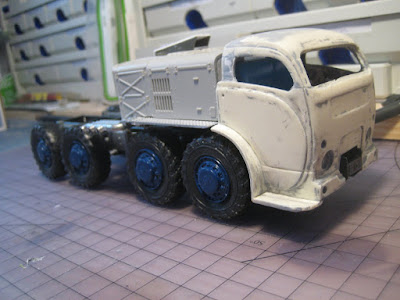So in a fit of weakness, I went out and splurged on one of Model Factory Hiro's 1/12 kits, specifically the 1961 Ferrari 156, known as the Sharknose for its distinctive radiator fairing, as driven by Phil Hill to the championship that year.

One reason for doing this is that it appears MFH has lost their license from Ferrari to sell kits, so once existing stock is gone, that's it. And the vultures are selling this stuff for a fortune on eBay.

Gotta give MFH credit: ordered from Japan on July 21, delivered in Eastern Canada on July 26. So on to the box, classy as always:

The new MFH kits feature more resin and less white metal than past kits. This kit has a resin engine, and I am sure the result is a significantly reduced weight overall. (Some online posts describe the 917K at this scale wanting to bend in half, due to the weight of the big flat 12 when cast in white metal). That being said, the kit clocks in at 1100 grams, of which the seven bags of white metal bits represent 800 grams.

The wheels in particular look to be gorgeous, but I have to do the lacing up myself; this occupies a full two pages in the instruction manual.

There are only three photo-etched sheets, and a few mechanical bits like springs and screws in a separate bag. There is a piece of blue velours on sticky backing for the seat upholstery, and I hope that this will be relatively easy to keep clean once built.

So on to the baggies of white metal bits.

The first baggie, the biggest one, has a range of chassis bits. Lotus had monocoques by 1961, but Ferrari was sticking with the familiar tube frame. Fortunately these are nice and sturdy, unlike the 1:24 tube frames from MFH that I have assembled.

Sadly, the jig for lacing up the wheels is bent. I am told that MFH service is wonderful so I may try to get a new one.

Baggies 2 and 3 contain different bits related to bodywork and interior, as well as cam covers and exhaust pipes. After the spaghetti maze of the 908 and 917 exhaust systems, the simple V6 pipes are a joy.

More bent sheet but that is OK.


Baggie 4 is more engine bits along with brakes and suspension bits. There is also a large selection of 'bolts', some of which may get replaced by actual #00-80 bolts.

Baggie 5 has chassis struts, A-arms and an assortment of more or less bent tubes.

Baggie 6 has a mix of stuff, much of it unidentifiable at this stage. The battery is remarkable, being a 12V and a 6V battery wired up in series for 18V. I wonder what needed 18V in a 1961 GP car? The early version of the car had an additional 6V battery mounted immediately behind the dash. A fuel pump and a couple of magnetos ought to do it in my view, especially when dealing with the electrical needs of a carburetted 1.5 litre V6 making 190 hp. Then it occurred to me to have a good look through the manual: it appears there is no alternator to keep it all recharged. So the car gets a fresh battery on race day and off we go!

Finally Baggie 7, which I won't open just yet, is a load of little pins, rivets and other assorted connecting bits.

The little 120 degree V6 is made up of about 6 resin parts, plus the transmission. It's all on a sprue and looks almost like styrene. The 156 engine (meaning 1.5 litre, 6 cylinder) in previous years was a 65 degree unit; the new flatter engine for 1961 was balanced (which a 65 degree unit will never be) and could thus rev higher, as well as having a lower centre of gravity. Partly as a result of the new motor, and partly due to the driving of Phil Hill, the new car was unbeatable in 1961. The aluminum rims are just lovely and getting them straight will be a major operation, even with a straight jig.

All in all a classic shape. The kit does not, yet, appear to have much more detail than a 1:24 kit, so hopefully easier ... but the quality of final paint on the body will make or break it. Do I dare use Tamiya rattle cans? Stay tuned!


















































